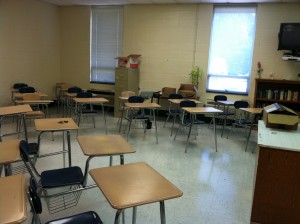Before I started this blog post, I read through everyone’s entries on their “something learned” that would impact students—all the posts are so inspiring, and I can feel the positive energy!
I am actually surprised how much my instructional plans are changing this year. Since my externship mainly involves working with teachers, I wasn’t sure how much it would translate into my teaching right away. However, thanks to both talking with and getting ideas from you all and the professional development we received, I am more willing to try out more nontraditional ideas in the classroom.
Three things I have already tried out this week that have been very successful while still keeping my classroom orderly, focused, and peaceful:
1. The first one was minor, yet representative of this year’s change, and it all started from a mild disappointment. I was moved (not my choice) to a much smaller room, and had to figure out how to fit 28 desks in a way that would accomodate 18 year olds! This is a rough view of what some of my coworkers and I came up with:

This picture doesn’t really tell the whole story of the seats, which are carefully angled and staggered to create the most space possible. My coworkers came and helped me design it after I kept hanging out in their rooms to plan because I didn’t even want to look at mine.
In six years of teaching, I have always had my desks facing front in straight rows. This new method lets me be really “in” the classroom instead of just standing in front of it. It’s much more squished than my old room, but I’ve taken to calling it “cozy.”
2. Making sure that students have a chance to move at least once EVERY CLASS (except on test days). I’ve thought of very simple ways to do this, like: I had a students do a quickwrite related to that day’s lesson. Then, instead of just discussing as a class, I had them get up and give it to someone on the other side of the room. They wrote a response to that student’s quickwrite and wrote down further ideas for that person to consider. Then I had them get up and trade again. By the time it came to class discussion, they had gotten two chances to stretch their legs (important during a 90-minute block, yikes) and warm up to the discussion. I ended up getting MANY more hands raised than I usually do at first.
3. Attaching short, creative activities to more standard assignments. For example, after an analysis assignment on the essay “Homeless” by Anna Quindelin, I had students grab colored paper and some art supplies–that I made sure I am fully stocked with this year–and had them write the word “shelter,” draw whatever they associated with “shelter,” and then write down words and phrases they associated with it. I then had them turn the paper over and do the same thing on the back with the word “Homeless.” Each student then did a short presentation of why they picked what they did for both sides (this and grabbing the art supplies was their stand-up for the day). This actually turned out to be VERY valuable and had the students realize stuff about themselves and their assumptions about others that informed our discussion of the article.
I deeply appreciate being able to make connections with talented teachers across the state who shared how they use innovative classroom techniques to help students. This week has taken a lot of extra work on my part, but I’m loving it. Next stop, more technology (maaaaybe after I catch up on all this grading…)!